The Pyramids Variations
Memorising the Chord Sequence
It’s easier to play Pyramids without delays if you know the chord sequence by heart. You will also enjoy playing more when you are sure of the chord sequence. Also, improvising is nearly impossible without knowing the chord sequence by heart.
Memorising the line the roots make
Because all the chords used in the build-up to the Concert Performance are simple BMP chords with the root (the name-note) at the bottom, if you learn the line the roots of the chords make, you will learn the chord sequence as well.

This little study, which squeezes all 16 bars of Pyramids into one line of music, lets you see and rehearse the zigzag shape the roots make as you play through the chord sequence.
Play this study using just your first fingers. Using the same finger for all the notes makes you more aware of the size and direction of the jumps.
You don’t even have to read the music – the notes you play are the notes named by the chord symbol. Here they are, shown on a keyboard:

Play the bass line over and over again saying the names of the roots as you play them.
It helps to sing the bass line. You don’t have to be able to sing at all well – you just have to try to get the overall shape right.
Using the shape of the bass line to help you
Here is the same zigzag line the 16-bar A1-A2 version bass notes make, squashed and stretched so that you can see its shape more clearly.

Different people remember things in different ways. You might find the following activities help you memorise the bass line, and thus the chord sequence.
- Trace the zigzag shape of the bass line with your finger. Memorise the shape.
- Draw the zigzag bass line in your mind’s eye as you hum the bass line to yourself.
- Play the bass line with your index fingers again, observing how the sound has the same ‘shape’ as the zigzag bass line.
Here are some more activities that might help.
The bass line ladder
In the next diagram, the roots are arranged vertically with the highest note A at the top and the lowest E at the bottom, so what is higher up on the page is a higher note too. The arrowed line shows the movement of the roots in the first and second halves of a 16-bar Pyramids version.
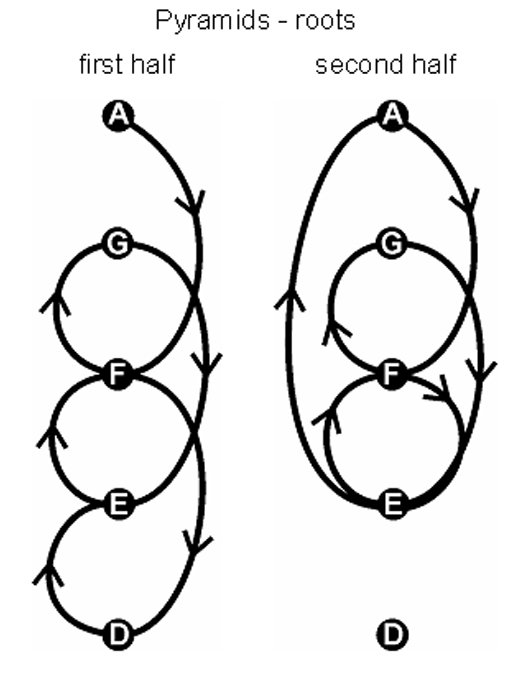
Check that you can see how the lines follow the roots:
First half: A – F – G – E – F – D – E
Second half: A – F – G – E – F – E – A
To help you memorise the chord sequence, tap the roots on the ‘blank’ diagram below with your finger as you sing or hum the bass line tune to yourself. You don’t actually have to follow the curly shape in the first diagram as long as you tap the dots in order.
After a few goes with your eyes open, do the exercise with your eyes closed. Sing the bass line and tap the piece of paper where you think the dots are.
You won’t know exactly where the dots are, but make as sure as possible that your third bass note ‘G’ is halfway between your ‘A’ and your ‘F’, for example, and that you jump over the imaginary ‘F’ to get to ‘E’.
Make a special effort with the last three bass notes of each half:
A – F – G – E (end of the first half) F – D – E
A – F – G – E (end of the second half) F – E – A
Steps, skips and jumps
The roots of the chords move three different distances:
- a step – to the next-door white key, either up (right) or down (left),
- a skip – over the next-door key to the one beyond, or
- a jump – over more than one white key (bigger than a skip).
Here’s a table showing the distances the Pyramids bass moves between notes.
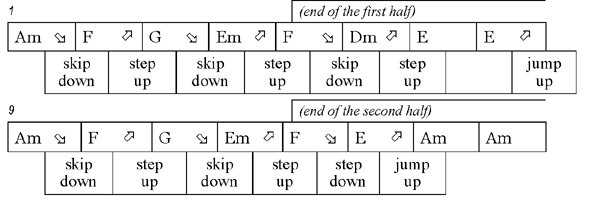
Here is the zigzag Pyramids bass line shape marked with steps, skips and jumps.

Here is the roots ladder with the size of the movements marked.
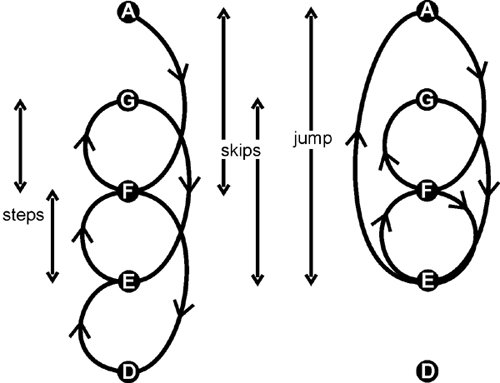
All three diagrams show the same thing. Work through them making sure you can see how the skips, steps and jumps shown in the table at the top match the distances shown in the line and ladder diagrams.
- Describe the movement of the bass line to yourself in words – when it moves down and when up, and by how much.
- Do all the previous exercises calling out whether the movement is a step, a skip or a jump.
- Sing the bass line naming the sizes of the movements. Sing: “Start on A, down a skip (F), up a step (G), down a skip (E)…” and so on to the end.
Two halves with different endings
Look at the shape of the line the roots make.


If we place the first-half shape (bars 1 to 8) above the second-half shape (bars 9 to 16), we can see that both lines are the same as far as the second F chord:
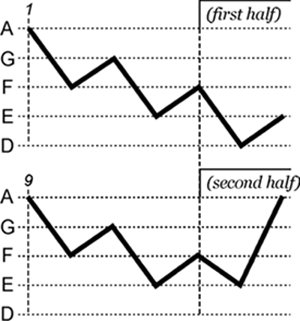
Only the endings of the lines are different.
- The last three chords of the first half are F, Dm, E
- The last three chords of the second half are F, E, Am
If you can remember the different way the two halves end, you can probably remember the whole sequence.

Here is your exercise:
- Play or hum the bass notes at the end of the first half (F, D, E), followed directly by the bass notes at the end of the second half (F, E, A).
Here’s the chord chart with the ends of the first and second halves highlighted.

Another very useful and effective exercise is to play the two different endings as you say or sing exactly what it is you are trying to learn.
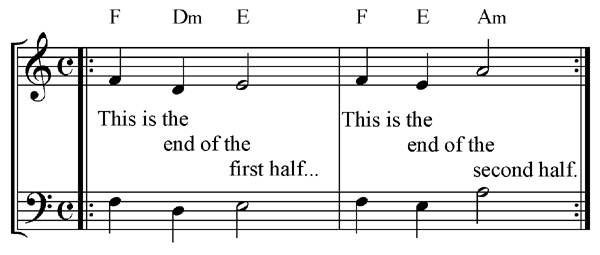
It pays to start every Pyramids practice session with one or two of the line-of-the-roots
exercises in this section to remind yourself of the Pyramids chord sequence
If your performance has any delays which show you are unsure of the chord sequence, go back and drill that part of the bass line.
You can't enjoy creative freedom if you're unsure of the basics!
The visual prompt sheets
Musicarta has drawn together two selections of important illustrations you can build your basic performances from. Print the pages of your Workbook out, put them on your music stand, and see how far you can get!
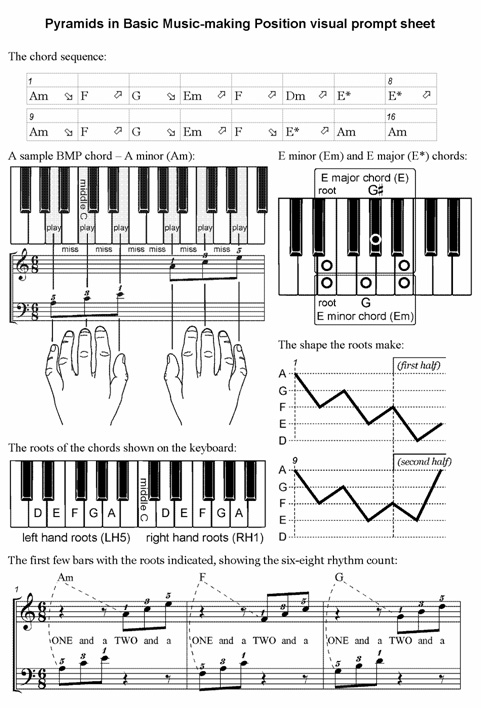 |
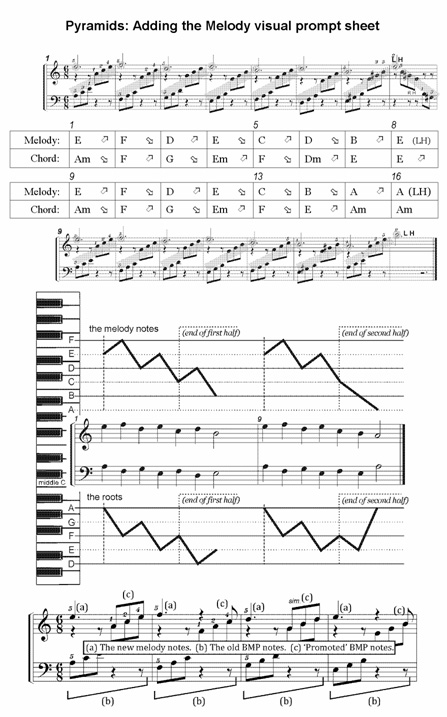 |
|
OUT NOW! |
THE MUSICARTA BEAT & RHYTHM WORKBOOK At last! An effective approach to keyboard rhythm & syncopation skills. Learn more! |
ONLY $24.95! |
PYRAMIDS |